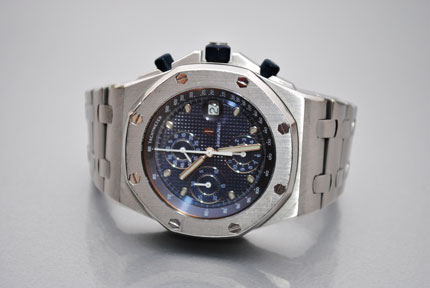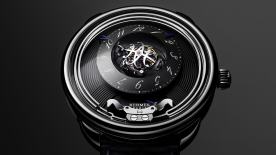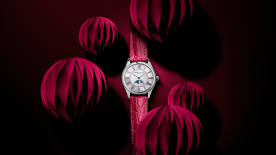Worldtempus - 5 March 2013
Miguel Seabra

Two celebratory years in a row would have been decidedly too much: Audemars Piguet celebrated the 40th anniversary of the iconic Royal Oak in 2012 and chose not to commemorate the 20-year anniversary of the Royal Oak Offshore this year, opting to wait for its 25th birthday instead. Yet, looking at the company's new products recently unveiled at the Salon International de la Haute Horlogerie, 2013 is all about the “incredibly charismatic and virile” (in Audemars Piguet's own words) Royal Oak Offshore: there's a grand complication combining minute repeater, perpetual calendar and split-seconds chronograph that became the latest star in the catalogue, a new Royal Oak Offshore Chronograph featuring an all-ceramic case and bezel, a new Royal Oak Offshore Diver also made of deep black high-tech ceramics, and even a new blue-dial Perpetual Calendar Chronograph within the traditional Royal Oak Offshore case.

New variations of the Royal Oak Offshore recently unveiled: the grand complication and the black chronograph in high-tech ceramics © Audemars Piguet
Exactly 20 years ago, Audemars Piguet was cautiously preparing the launch of the Royal Oak Offshore at the 1993 edition of Baselworld, where the brand used to exhibit its collections before moving to the Salon International de la Haute Horlogerie in Geneva. And the feeling was almost the same as it was in 1972, when the company launched the original Royal Oak. How would the watchmaking world and haute horlogerie aficionados react to such an enormous timepiece?
The creator of The Beast
That chunky timepiece was almost immediately called “The Beast” by insiders, so voluminous the 42-milimeter case was for that time's standards. But, just like its predecessor Royal Oak established a new era two decades previous, the Royal Oak Offshore set new contemporary standards in terms of dimensions. Geneva-based Emmanuel Gueit, 45 years old, now the owner of a design bureau specialized in watches and luxury products, was the man behind the concept and told us all about the morose and frequently interrupted process that led to the presentation of the Royal Oak Offshore.

Live SIHH pictures of the Royal Oak Offshore Diver in ceramic and the most recent “traditional” Royal Oak Offshore combining chronograph functions and perpetual calendar © Miguel Seabra
“I started my career at Audemars Piguet as a junior designer; they had a department directed by Jacqueline Dimier, who took charge of the department after Gérald Genta left in 1972,” says Gueit. “My parents had decided to send me to England to a college for some time and before going I met Madame Dimier to sell her my designs and get some pocket money; the designs didn't interest her that much but she offered me a position after coming back from England…I was too immature then, I was only 19. When I came back, I started in 1986 and worked 13 straight years at Audemars Piguet. I left when I was the company's art director.” Gueit's pedigree helped him establish his career: “My father Jean-Pierre was a well known watch designer and knew the horology jet set, he was the one that opened up Audemars Piguet's doors for me – he worked for Piaget and not only did the first Harry Winston pieces but also designed for Patek Philippe, Vacheron Constantin, Rolex, Concord and Movado.”
Rejuvenating the Royal Oak
So what was the concept behind the original Royal Oak spinoff? “I was 22 at the time and Stephen Urquhart [now CEO of Omega –ed.], who was then at the helm of Audemars Piguet, told me to study a Royal Oak for young people. At the time, by 1989, there was this new trend: women were wearing men's watches…I didn't like the idea that much, so I thought of creating an oversized, masculine timepiece. Stephen, my mentor, liked the project straight away.” But it wasn't that easy to make the idea concrete. “We took four years to launch it because every six months I was asked to stop it – people would say it was too big, too heavy, non-commercial. People were not ready for it and didn't believe in it – no one, except me. I was convinced and secretly kept on developing the concept. Finally, in 1992, I introduced the project and Stephen told me, ‘Ok, we'll do it so you can be happy'…”

There were some constraints that prevented the launch of the Offshore that year. “It was supposed to be launched in 1992 to commemorate the 20th birthday of the Royal Oak, but there were innovative elements that we had to deal with – the first crowns and pushers in silicone, the joint between the bezel and the case. Overall, the idea was to keep the same look while giving the Royal Oak a more youthful look, because at the time its sales were a bit down – it was imperative that we look for a new kind of customer. Stephen taught me everything about marketing; from the beginning he showed confidence in my project – but everyone else thought we were crazy.”
One furious iconoclast…
Was there a specific inspiration behind “The Beast”? Not quite: “Gérald Genta's original Royal Oak was my sole inspiration and my goal was to change it without really changing it.” The case was too big for the modular caliber, so the movement was set inside an anti-magnetic inner case that became a sales asset. Plus, as always in high-end watchmaking, an appropriate name can contribute a lot to legend status – and the Offshore designation, reminiscent of expensive powerboat races and exclusive maritime adventures, turned out to be ideal. “It was Stephen that had the idea to name it Offshore, but in the beginning they wouldn't engrave the name Offshore on the back of the first 100 pieces – actually, they were afraid of destroying the Royal Oak. But then they changed their minds.” Those 100 non-marked pieces are worth a fortune by now – and Gueit has number 39.

When the Offshore was finally introduced in Basel, a lot of purists called it sacrilege. Including one that should have known better, considering that he was accused of being an iconoclast twenty years before. “Gérald Genta invaded the booth shouting that HIS Royal Oak had been completely destroyed,” recalls Gueit, adding that another individual that became a well-known creator of “different” timepieces wasn't impressed at all either: “I remember that, after the launch of the Royal Oak Offshore in Basel, I had lunch with my friend Maximilian Büsser – who was then product chief at Jaeger-LeCoultre – and he told me, ‘You are completely crazy; you're never going to sell such a monster'.” My, how times change…
Coloring the “Monster”
The first Royal Oak Offshore boasted the same color scheme as the original Royal Oak: blue dial, but with a bigger Tapisserie guilloché pattern. The other colors came later. “For the 25-year celebration of the original Royal Oak in 1997 we did a festive booth at Baselworld with colorful Offshores in violet, brown, apple yellow, orange, turquoise…actually, it was just for fun, but people really liked it and ordered a lot.” Another color would soon become significant: “In that same year I created the Royal Oak Offshore End of Days for Arnold Schwarzenegger – and with it, a new direction was opened in luxury watchmaking: black watches.” The Offshore line rapidly became the ideal experimentation ground for Audemars Piguet, with avant-garde materials and ultra-sporty limited editions featuring the signatures of its ambassadors.

Arnold Schwarzenegger and the Royal Oak Offshore End of Days © Audemars Piguet
Emmanuel Gueit, who also created the oval Millenary in 1995 and the Jules Audemars lines, left Audemars Piguet in 1999 to establish his own company, EG Studio. “After I left, they picked up my project of a Royal Oak Offshore with a rubber bezel and strap.” It was his latest legacy. These days, Gueit admits he has lost touch with Audemars Piguet and is critical of some of the brand's adaptations of his Royal Oak Offshore, but there's something that pleases him. “I'm really happy to see François-Henry Bennahmias at the head of the company. He is a tasteful and intelligent man. After I left, Audemars Piguet never invited me back to any of their events…François will know where to find me”. Indeed: if we did, surely Bennahmias will!





